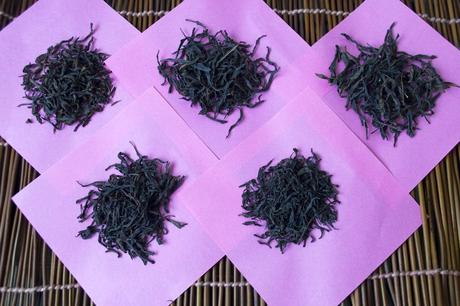“I just had a Dancong.”
“That’s great! Which one?”
“There’s more than one?”
Depending on how you define it, there can be over a hundred types of Dancong but we are getting ahead of ourselves.
In Part I, we looked at what is a Dancong while we examined the origins of Dancong in Part II.
This post is about the different types of Dancong.
Geographical Distinction
The birthplace of what is known as Dancong is Phoenix Mountain or Fenghuangshan (凤凰山) which you can see on Google Map.
It is located in Chaoan (潮安) District, Chaozhou (潮州) City in Guangdong (广东) Province.
Within the Phoenix Mountain belt, there are several peaks or mountains such as Mount Wudong (乌岽山), Mount Wanfeng (万峰山) and Fengniaoji (凤鸟髻).
Of these peaks, Mount Wudong is home to the best known and best regarded Dancong and is widely regarded as the birthplace.
All teas grown in the Phoenix Mountain belt are often referred to collectively as Fenghuang Dancong (凤凰单丛) or Phoenix Dancong.
Non-Phoenix Dancong
While Phoenix Dancong enjoys the greatest repute, surrounding areas in Guangdong and Fujian also produce Dancong of their own.
In 1956, the district of Raoping 饶平 (refer to Google Map above) bought 3000 to 4000 saplings from Daping Village (大坪村) in Mount Wudong. After much work and research, in 1965 40 trees were harvested commercially.
After the success it was slowly replicated- while factoring in the regressive years of the Great Leap Forward and Cultural Revolution- by the 80s Dancong was commonplace in Raoping, especially Lingtou (岭头).
By the 90s, Lingtou Dancong has been given trademark protection and Lingtou Dancong is also commonly known as Baiye Dancong (百叶单丛) or ‘White Leaf Dancong’.
It didn’t stop there though, eventually the cultivar was cloned and grown in neighboring regions such as Xingning (兴宁) and Dapu (大埔) and eventually in other parts of Guangdong, Fujian and even Hainan and Guangxi.
Different Types of Phoenix Dancong
There are more than 100 different types of Dancong documented in the Chaozhou Chronicles but they are commonly sub-categorized into 1 of the following 10 based on their distinct fragrance:
- Huang Zhi Xiang (黄枝香) or Yellow Sprig Fragrance
- Zhi Lan Xiang(芝兰香) or Orchid Fragrance
- Mi Lan Xiang(蜜兰香) or Honey Orchid Fragrance
- Gui Hua Xiang(桂花香) or Osmanthus Fragrance
- Yu Lan Xiang(玉兰香) or Magnolia Fragrance
- Jiang Hua Xiang (姜花香) or Ginger Flower Fragrance
- Ye Lai Xiang(夜来香) or Tuberose
- Xing Ren Xiang (杏仁香) or Almond Fragrance
- Rou Gui Xiang(肉桂香) or Cassia Fragrance
- You Hua Xiang(柚花香) or Pomelo Flower Fragrance

Clockwise Left to Right (Top Left)- Huang Zhi Xiang, Zhi Lan Xiang, Tong Tian Xiang, Xing Ren Xiang and Mi Lan Xiang
Out of this list, we will just look at 2 of the best known ones.
Huang Zhi Xiang
It would not be inaccurate to call this the Shifeng Longjing of Dancong.
It is probably the best-regarded variety and just like Shifeng Longjing, the most prone to ahem, inauthentic versions.
The excellent 凤凰单丛 by 叶汉钟 et al (from which much of the information in this post was researched from) listed 7 different trees under the Huang Zhi Xiang ‘family’ of which the most famous one is “Song Tea” (宋茶) grown in Li Zai Ping( 李仔坪) Village in Mount Wudong.
During the Cultural Revolution, this was renamed a non-subtle “East is Rising” or Dongfang Hong (东方红). No prizes for guessing who the tea was for.
In the 80s though, with the new leadership in place, the nationalistic name was eschewed and reverted to its original name.
Huang Zhi Xiang is probably the most imitated form of Dancong (though not the most common) with many cheap versions flooding the market. Some of them are actually pretty decent but quite some way off what is considered as the authentic versions of Huang Zhi Xiang which are pretty pricey, even by Dancong standards.
Mi Lan Xiang
Mi Lan Xiang is unquestionably the best known variety of Phoenix Dancong and certainly the most commonly available. In my opinion, this has both its merits and faults.
Because of its widespread availability, a Mi Lan Xiang priced the same as another variety of Dancong is most likely to be of a higher production quality- competition can have this impact.
At the same time, many of the Mi Lan Xiang available on the market at grown at low elevations and generally of a lower quality, riding on its fame.
Nevertheless where you can get a quality rendition (ahem, for example), it provides a great introduction to the rewarding world of Dancong at the price.
See here for other articles related to varieties of oolong tea
See more articles on overviews of various categories of tea
